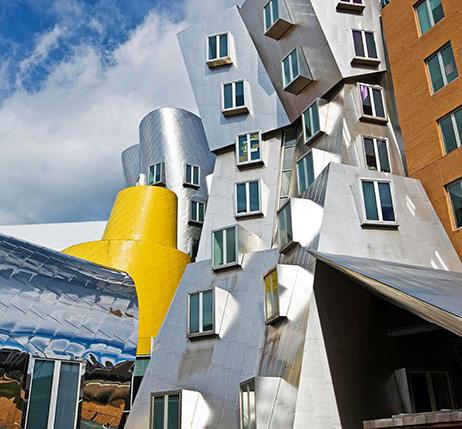
4 minute read
The Architecture of Frank Gehry



Born in Canada in 1929, the 1989 Pritzker Prize–winning architect Frank Gehry graduated from the University of Southern California and the Harvard Graduate School of Design. He started his own firm in California in 1962, and, since then, has been responsible for some of the most spectacular and recognizable buildings in the world, almost every one of which could be a Wow Factor in its own right.
1. The Guggenheim’s satellite museum in Bilbao, Spain, which opened in 1997, is a mountain of stone, glass, and titanium was a major boost for the Bilbao economy. American architect Phillip Johnson (who died in 2005) called it “the greatest building of our time.” accidentally walked through a spider web. after complete.indd 36 3.02.2019 18:55 may be blind, but marriage is a real eye-opener.

4. Built and named for advertising agency Chiat/Day, the 1991 Venice, California complex goes by the nickname Binoculars Building, because of the giant pair of binoculars at the entrance to a parking garage. The office structure itself resembles a ship’s prow.
8. In 1999, the Neuer Zollhof complex spurred the transformation of Dusseldorf, Germany’s waterfront into what is now called the Media Harbour. The popularity of the buildings earned the towers a spot in the German edition of Monopoly.
9. Built in 1996, the Dancing House is home to the Czech republic’s Prague offices of Dutch insurance company Nationale-Nederlanden. It is affectionately called ‘Fred and Ginger’, thanks to its signature pair of towers, which seem to resemble a couple dancing.

5. Gehry was propelled into institutional work when commissioned to expand Loyola Law School in 1978 He reimagined the downtown Los Angeles site as a neotraditional campus and developed a strategy to allow the expansion of the campus in phases, based on the priorities of the school. The last phase was completed in 2003.
Love may be blind, but marriage is a real eye-opener.
6. The Olympic Fish Pavilion in Barcelona, Spain is a huge golden steel-mesh fish sculpture created for the 1992 Olympic Village. It was a technological breakthrough for the architect’s studio, which used three-dimensional aeronautical-design software to realize the concept.


2. Completed in 1993 (and now including a Gehry-designed expansion finished in 2011), the Weisman Art Museum is on the University of Minnesota campus in the Twin Cities.



3. The Walt Disney Concert Hall in Los Angeles opened in 2003. Evidencing Gehry’s passion, its exterior has expanses of stainless steel ‘sails’ that appear to flutter above the avenue.


7. The 8,000-square-foot Vitra Design Museum opened in 1989 in Weil am Rhein, Germany on the campus of the furniture manufacturer (Vitra). It features simple geometric forms with white plaster surfaces and zinc roofing.
11. Commissioned 14 years ago by Frankfurtbased DZ Bank & Hines to design a branch across from the Brandenburg Gate in Berlin, Germany (where local code prohibits any building from outshining the triumphal arch), the DZ Bank Building has a sober limestone façade, but a spectacular stainless-steel conference room in the atrium (the shape of which Gehry compared to a horse’s head).
Arachnoleptic fit: the frantic dance performed just after you’ve accidentally walked through a spider web.
Arachnoleptic fit: the frantic dance performed just after you’ve accidentally walked through a spider web.
12. Built in 2002, the Peter B. Lewis Building houses the Weatherhead School of Management at Cleveland’s Case Western Reserve University. The building has ribbons of stainless-steel unfurling from a brick base; its open interior is meant to encourage cross-disciplinary socializing.
13. In 2007 in New York City, the IAC Building (home to InterActive Corp’s headquarters) was completed in the city’s Chelsea neighborhood. The 9 story building was Gehry’s first major glass building, and crews bent that material on site to capture the swelling effects in his sailboat-like design.

14. Opened in 1994 as the headquarters of the American Center of Paris, this building closed a year and a half later. In 2005 it became home to the Cinémathèque Française, a theater and archive of film history.
17. The Ray and Maria Stata Center for Computer, Information and Intelligence Sciences in Cambridge replaced Massachusetts Institute of Technology’s Building 20 in 2004. It was designed specifically to encourage occupants to interact with one another.



18. Born in Toronto in 1929, Gehry celebrated his first Canadian project there, a renovation of the Art Gallery of Ontario, just a few months shy of turning 80 in 2009. There had been three previous expansions of the 1918 museum.



22. In 2013, in Panama City, Panama, Gehry completed the Biomuseo, an ecology museum. But it wasn’t until 2013 that the project was finally realized. The choice of reds, greens, and other bold hues is a direct nod to Panama’s diverse flora and fauna.

23.
15. Gehry combined red brick with a gleaming stainless-steel roof for this structure in 2005 in Herfordm Germany. The Marta Herford Contemporary Art Museum incorporates a former textile factory that existed on the site.

16. Gehry likened the stainless-steel façade of the Richard B. Fisher Center for the Performing Arts at New York’s Bard College (in Annandaleon-Hudson) to a theatrical mask. Completed in 2003, geothermal energy systems and other green strategies were incorporated into the building’s de sign, allowing it to run largely free of fossil fuels.


19. Constructed between 1999 and 2004. the Jay Pritzker Pavilion played a major part in the transformation of the downtown Chicago rail yards into Millennium Park public square. The concert-hall acoustic system has been treating audiences since then.

20. Completed in 2014, the Fondation Louis Vuitton is set in a Paris park. The shiplike exterior includes 12 glass “sails,” which cover the concrete-clad gallery spaces.

21. Ripples cover the exterior of New York City’s Beekman Tower—8 Spruce Street—as if a giant Super Ball had ricocheted through its interior. These pleats also function as bay windows for residents of the 76-story apartment building, which opened in 2011.











